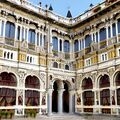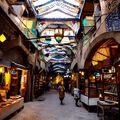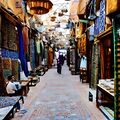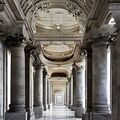Bitanga
Bitanga, Capitol District: Jewel of Lutezzik
Bitanga, the Capitol District of Lutezzik, is a captivating and vibrant city renowned for its picturesque canals, splendid architecture, and rich cultural heritage. Nestled at the convergence of the majestic Ursus River and the Quari Sea, Bitanga's unique charm and strategic location have earned it the reputation of being the Jewel of Lutezzik. Bitanga embraces its rich history while also embracing innovation and modernity. The city's commitment to sustainable practices is evident in its well-maintained green spaces, eco-friendly architecture, and forward-thinking urban planning.
Bitanga and the Capitol District embody the spirit of a place where history, art, and culture converge seamlessly. Its captivating canals, stunning architecture, and warm hospitality create an enchanting experience for visitors and residents alike. As the Jewel of Lutezzik, Bitanga stands as a testament to the harmonious coexistence of tradition and progress, captivating the hearts of all who have the privilege of experiencing its allure.
Historical Roots
Bitanga traces its origins back to ancient times when it was established as a small fishing village along the banks of the Ursus River. Over the centuries, the city grew and flourished due to its strategic position as a crucial trade and transportation hub. Bitanga's prosperity attracted people from diverse cultures and backgrounds, creating a rich tapestry of traditions and customs that continue to shape the city's identity.
Canals and Waterways
A defining feature of Bitanga is its intricate network of canals and waterways that crisscross the city. Bitanga's canals serve as its lifeblood, providing a charming and efficient mode of transportation for residents and visitors alike. Pallasian-inspired gondolas glide gracefully along the water, offering tourists enchanting rides to explore the city's scenic beauty.
Architecture
Bitanga's architecture is a delightful fusion of old-world charm and modern ingenuity. Bitanga boasts elegant gabled buildings that line the waterways, the facades of these historic structures display an array of colors, adorned with intricate carvings and ornate detailing, reflecting the city's artistic prowess and rich cultural heritage.
Bitangan architecture continues to evolve, with contemporary structures seamlessly blending with historical landmarks. Each building narrates a unique story, intertwining the past with the present, and inviting visitors to experience the charm of this captivating city. Bitanga's architectural marvels, from its grand palaces to its bustling marketplaces, represent not only a reflection of the city's history but also a testament to its enduring spirit of creativity and cultural fusion.
Bitangan Architecture, is renowned for its captivating beauty and practical design, and stands as a testament to the city's rich history and artistic sensibilities. Influenced by a blend of cultural styles and inspired by the city's unique landscape, Bitangan buildings are characterized by their intricate facades, distinctive canal-side structures, and efficient use of space. The city's architectural heritage is an embodiment of its cosmopolitan nature, echoing the diverse backgrounds of its inhabitants.
The Grand Venacia Palace
One of the most iconic structures in Bitanga, the Grand Venacia Palace, showcases a harmonious blend of architectural influences. Built during the city's golden era, it boasts majestic domes, arched windows, and intricate stonework that reflects the elegance of Bitangan and Lurossi architecture. Situated along the Regal Canal, the palace is adorned with lush gardens and sculpted fountains, creating an enchanting atmosphere for visitors and residents alike. Today, the Grand Venacia Palace serves as the residence of the Federation's President today and remains a symbol of Bitanga's grandeur of old.
The Sapphire Bazaar
Nestled within the heart of the old city, the Sapphire Bazaar is an architectural marvel that captures the essence of Bitanga's bustling trade history. Its labyrinthine design, reminiscent of Taki souks, meanders through a series of covered alleys and open courtyards, creating a vibrant marketplace where merchants from across the federation converge to showcase their wares. The bazaar's iconic azure-tiled domes serve as a beacon, guiding travelers from afar to explore the city's vibrant commercial center.
The Lotus Courthouse
A structure that exudes both solemnity and grace, the Lotus Courthouse is an example of Bitangan Neo-Classical architecture. Its imposing marble columns and symmetrical design draw inspiration from the great courthouses of ancient civilizations, while the intricately carved lotus motifs pay homage to the city's sacred flora. Serving as the seat of justice and a symbol of the rule of law, the Lotus Courthouse now houses the Federation Supreme Court and the Supreme Court of the Republic of Esserix.
The Azure Gondola Theater
Standing on the banks of the main canal, the Azure Gondola Theater is a testament to the city's love for the performing arts. This architectural masterpiece is designed to resemble a grand gondola, its façade adorned with blue and white mosaics reminiscent of Esserix's Delftware. The theater plays host to an array of cultural performances, including opera, theater, and concerts, attracting both locals and tourists who are enthralled by its elegant beauty and world-class acoustics.
The Crystal Observatory
Perched atop Mt. Tricipeto overlooking the city, the Crystal Observatory is a marvel of modern Bitangan architecture. Its futuristic glass facade allows visitors to stargaze and witness breathtaking panoramic views of the city. Inspired by cutting-edge design principles, the observatory has become a center for scientific research and astronomical exploration, contributing to Bitanga's reputation as a hub of knowledge and innovation.
Cultural Melting Pot
Bitanga's cultural diversity serves as a reminder of the historic cosmopolitan character of the Bitangans. The city's bustling markets, vibrant festivals, and art galleries are a testament to its cultural vibrancy. Bitanga's people embrace their heritage while welcoming visitors from all corners of Lutezzik and beyond, making it a melting pot of ideas, traditions, and experiences.
The Floating Market and Festivals
One of Bitanga's most celebrated features is its floating markets, inspired by the age-old markets of the Quari and the floating flower markets of Argealon. Colorful boats laden with fresh produce, arts, and crafts meander through the waterways, creating a vibrant ambiance that captures the essence of the city's spirit.
The city also hosts an array of lively festivals throughout the year, each with its unique charm. From the dazzling Festival of Lights, illuminating the city with a kaleidoscope of colors, to the exuberant Boat Parade Festival, Bitanga's celebrations leave a lasting impression on all who witness them.
The Floating Market of Bitanga
The Floating Market of Bitanga stands as a captivating testament to the city's unique charm and thriving commercial spirit. Nestled amidst a network of picturesque canals that crisscross the city, this lively aqua bazaar is a vibrant spectacle that has enchanted locals and visitors for centuries. Combining traditional market practices with the city's distinct maritime lifestyle, the Floating Market is an essential part of Bitanga's cultural heritage.
The Floating Market weaves through a labyrinth of waterways, providing an enchanting scene of traditional wooden boats adorned with colorful awnings and fragrant flowers. Each boat serves as a floating stall, creatively arranged to display a diverse array of goods, including fresh produce, handcrafted souvenirs, textiles, and local delicacies. The bustling market is a feast for the senses, as the aroma of freshly prepared street food mingles with the vibrant colors of the goods on display. Reflecting Bitanga's cosmopolitan identity, the Floating Market is a melting pot of cultures and influences from across the federation. Traders and vendors come from various regions, bringing with them a diverse range of products and culinary delights. Visitors have the opportunity to interact with people from different backgrounds, fostering a deeper understanding and appreciation of the federation's cultural richness. The Floating Market is not merely a place for commerce but also a center of entertainment and cultural activities. Musicians, street performers, and traditional dancers often entertain the crowds, adding an atmosphere of merriment and celebration. Boat races, water parades, and cultural exhibitions are frequently organized, drawing tourists and locals alike to partake in the festivities.
Bitanga takes great pride in its commitment to environmental preservation, and the Floating Market is no exception. Vendors employ eco-friendly practices, such as using biodegradable packaging and minimizing waste. Additionally, the city encourages the use of solar-powered boats, reducing the market's carbon footprint and contributing to Bitanga's reputation as an eco-conscious destination. The Floating Market of Bitanga is a popular tourist attraction, drawing travelers from all corners of the federation and beyond. Local guides offer tours, narrating fascinating stories about the market's history, the significance of waterborne trade, and the city's cultural tapestry. For many visitors, a visit to the Floating Market is an unforgettable experience, as they immerse themselves in the sights, sounds, and tastes of this aquatic wonderland. The Floating Market of Bitanga continues to thrive as a vibrant hub of commerce, culture, and community, symbolizing the city's enduring maritime heritage and its embrace of diverse traditions. As a cherished hallmark of Bitanga's identity, the Floating Market remains a living testament to the federation's rich history and dynamic spirit, drawing visitors from far and wide to partake in its wide range of daily happenings.
Unification Day and Unity Month
Unification Day is an annual celebration observed throughout the diverse and culturally rich lands of Lutezzik. This joyous occasion marks a momentous event in the nation's history—the unification of various independent city-states and territories into a cohesive and united federation. It serves as a symbol of harmony, solidarity, and progress achieved through diplomacy and cooperation. The genesis of Unification Day dates back to the early years of the modern era, a time characterized by regional conflicts and political fragmentation. The city-states and territories of Lutezzik were divided, often at odds with each other, leading to strife, bloodshed, and instability. However, amidst this tumultuous backdrop, visionary leaders emerged who recognized the potential for greater strength and prosperity through unity.
It was on April 30, 1899 that these leaders from different regions came together, setting aside their differences, and signed the historic Treaty of Unity. This landmark agreement established the foundation for the formation of the Federation of Lutezzik, a political entity that would transcend geographical boundaries and foster cooperation for the greater good. Today, Unification Day is celebrated with fervor and enthusiasm across the federation. The festivities of Unity Month typically begin with a grand parade on April 1, featuring colorful floats representing each member state and their unique cultures. Citizens dressed in traditional attire proudly march alongside their leaders, displaying the unity that binds them as one nation. Cultural performances and art exhibitions take center stage during the celebrations, showcasing the diversity and creativity of Lutezzik's people. Traditional dances, music, and theatrical performances offer a glimpse into the rich tapestry of Lutezzik's heritage, reminding everyone of the beauty of coexistence and mutual respect.
Booths and stalls line Federal street for blocks, all the way to Federal Hall. They proudly display and sell traditional items from each member state. From the Republic of Esserix, there are always intricate handcrafted ceramics and one-of-a-kind delicate tapestries that speak of ancient craftsmanship. The Empire of Yastead showcases ornate jewelry and exquisite fabrics, reflecting their stained history of opulence and grandeur. The Luross Republic exhibits beautiful paintings and sculptures, embodying the essence of artistry and innovation that thrives in their beautiful homeland. The Democratic States of Dradena offer unique, environmentally friendly products, reflecting their continued commitment to sustainability and conservation. While at the Federated States of Ansson's booth, technological marvels and futuristic gadgets pique the interest of curious onlookers. And the Quar Alliance proudly displays their tribal artifacts, sharing stories of their close connection with nature, and the lands.
Unification Day also serves as an opportunity for reflection and gratitude. Citizens participate in various charitable activities, extending a helping hand to those in need and embodying the spirit of solidarity and compassion that unites the nation. Community feasts and gatherings throughout the month further strengthen the bonds between people from different walks of life, reinforcing the message that they are all equal participants in the tapestry of Lutezzik's progress.
As the sun sets on Unification Day, vibrant fireworks light up the night sky, symbolizing the collective hope and aspirations of the nation. The festivities of Unity month conclude on Unification Day (April 30) with a solemn ceremony, where leaders from different regions reaffirm their commitment to maintaining peace, promoting prosperity, and upholding the values that brought Lutezzik together in the first place. Afterward the Lutezzik National Symphony begins its annual performance for Unification Day on Bitanga's grand stage. It is a breathtaking spectacle that captivates the audience's hearts and minds. The Lutezzik National Symphony is renowned for its diverse themes and passion.
The performance commences with powerful overtures, symbolizing the unity and strength of the six member states of the Lutezzik Federation. As the music soars, it seems to evoke the essence of each state, painting vivid portraits of the distinct histories and cultures. Throughout the symphony, the audience is taken on an emotional rollercoaster, as the music transitions from lively and exuberant melodies to somber and contemplative movements. The orchestra skillfully weaves together various traditional instruments from each member state, creating a harmonious fusion of sounds that showcases the rich diversity of Lutezzik's heritage. In a breathtaking moment, the symphony reaches a crescendo as cannons are integrated into the performance. The booming sounds of the cannons firing reverberate through the air, creating a sense of grandeur and celebration. Symbolically, the cannons represent the resilience and fortitude of the Federation, signifying how it has overcome historical conflicts and emerged stronger and united. As the performance nears its conclusion, the symphony seamlessly transitions into the majestic finale. The music swells with emotion, carrying an overwhelming sense of pride and patriotism. The audience is enraptured by the extraordinary talent of the musicians, who pour their hearts and souls into each note.
Unification Day stands as a testament to the triumph of unity over division, reminding Lutezzik's people that they are stronger together and that their collective future is bound by a shared destiny. It serves not only as a celebration of the past but also as a beacon of hope for a brighter and more harmonious future for all who call Lutezzik home.
Culture and the Arts
Bitanga's love for arts and culture finds expression in its world-class museums, art galleries, and theaters. The Capitol District is home to some of Lutezzik's most esteemed artists, writers, and performers. The Bitanga Grand Opera House, and Azure Gondola Theater stand as a shining examples of architectural magnificence and host renowned performances that attract audiences from far and wide. Bitanga's culture has been a testament to the city's resilience, creativity, and passion for embracing both tradition and innovation. With a storied past that reverberates through its art, literature, and music, Bitanga continues to be a beacon of cultural expression and a haven for artists, intellectuals, and dreamers alike.
Development of Bitangan Culture
The evolution of Bitangan culture has been a captivating journey, shaped by a blend of historical influences, geographical uniqueness, and a steadfast commitment to innovation. From its early days as a humble fishing village to its present status as a bustling metropolis and the Federation Capitol, Bitanga's cultural identity has thrived through the ages, embracing diversity and nurturing artistic expression.
Bitanga's culture has been profoundly influenced by its maritime heritage. As a city built around intricate canals and waterways, the sea has always been an integral part of its identity. Fishing, boat-building, and waterborne trade have played significant roles in shaping local customs and traditions. Today, Bitangans continue to cherish their close connection to the water, fostering a unique maritime spirit that pervades all aspects of life. Throughout history, Bitanga has been a melting pot of cultures and influences due to its strategic location and status as a trading hub. The city's open-mindedness and acceptance of diverse communities have resulted in a cosmopolitan identity, where people from different backgrounds coexist. This cultural fusion has given rise to a rich tapestry of customs, languages, and art forms that form the vibrant fabric of modern Bitangan culture.
Bitangans have a deep-rooted tradition of embracing innovation and creativity. From the early days of maritime engineering to modern technological advancements, the city has continually fostered a spirit of exploration and ingenuity. This forward-thinking approach is evident in the city's architecture, transportation systems, and sustainable practices, making Bitanga a trailblazer in various fields.
Prominent Works of Art from Bitanga
"Eternal Aquatica" 1899
A masterpiece by renowned Bitangan painter, Lysandra Valerius, Eternal Aquatica is a mesmerizing representation of the city's intimate relationship with water. The painting captures the serene beauty of Bitanga's canals at dawn, with glistening reflections and vibrant colors. Valerius's artistry skillfully captures the essence of the city's maritime heritage, earning her international acclaim and recognition.
"Tales of Tides and Time" 1708
Authored by celebrated Bitangan writer, Alistair Darrow, Tales of Tides and Time is a captivating anthology of short stories that weave together myth, history, and fantasy. The book explores the connection between Bitangans and the sea, delving into folklore, maritime legends, and tales of heroic voyages. A literary gem, "Tales of Tides and Time" has become a beloved classic among both locals and global readers alike. This is one of very few primary sources from the Lost Age, much of what is speculated about the events of the Lost Age is derived from Tales of Tides and Time.
"Harmony of Horizons" 1912
"Harmony of Horizons" is an enchanting symphony composed by the esteemed Bitangan musician, Sofia Maran. Inspired by the city's diverse cultural influences and harmonious coexistence, the symphony incorporates traditional Bitangan melodies with musical elements from various regions within the federation. Its hauntingly beautiful melodies and evocative harmonies have earned it critical acclaim and made it an iconic representation of Bitanga's musical brilliance.
"The Floating Maiden" 1301
Crafted by the talented sculptor, Viktor Nereus, the Floating Maiden is an exquisite marble sculpture that stands tall on the banks of Bitanga's central canal. The artwork portrays a graceful maiden seemingly suspended above the water's surface, her outstretched arms welcoming visitors to the heart of the city. Symbolizing Bitanga's harmonious relationship with the sea and its reverence for femininity and nature, the Floating Maiden has become an iconic symbol of the city's beauty and resilience.
"Reflections of the Canals" 1921
Reflections of the Canals is a poetic anthology by the esteemed Bitangan poet, Isadora Lorelei. The collection is a lyrical exploration of the city's waterways, capturing the essence of Bitanga's soul as seen through the ever-changing reflections on its canals. Lorelei's verses embrace themes of love, loss, and hope, resonating with readers on a profound emotional level. Reflections of the Canals is treasured for its evocative language and deep appreciation for the natural beauty surrounding Bitanga.
"Rhapsody of Trade Winds" 1425
Composed by the celebrated Bitangan musician and conductor, Alexander Havensong, "Rhapsody of Trade Winds" is a symphonic masterpiece that pays homage to the city's history as a bustling maritime trade center. The music paints a vivid sonic portrait of the bustling harbor, capturing the spirit of merchants haggling over goods, ships setting sail, and the melodies of diverse cultures harmonizing along the waterways. "Rhapsody of Trade Winds" has enchanted audiences worldwide, and its performances in Bitanga's renowned concert halls are cherished cultural events to this day.
"Luminescent Nightfall" 1956
Created by the visionary artist, Celestia Thornbloom, Luminescent Nightfall is a breathtaking painting that captures Bitanga's magical allure under the moonlit sky. The artwork depicts the city's skyline with softly glowing lights reflected in the canals, creating an ethereal and dreamlike ambiance. Thornbloom's unique use of luminescent pigments adds an enchanting glow to the night scene, transporting viewers into a world of beauty and wonder. Luminescent Nightfall has become an artistic emblem of Bitanga's nocturnal charm.










